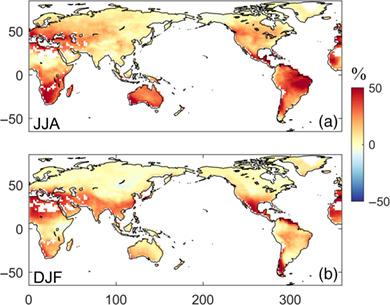当前位置:
X-MOL 学术
›
Int. J. Climatol.
›
论文详情
Our official English website, www.x-mol.net, welcomes your
feedback! (Note: you will need to create a separate account there.)
Projected increase in compound dry and hot events over global land areas
International Journal of Climatology ( IF 3.5 ) Pub Date : 2020-04-30 , DOI: 10.1002/joc.6626 Xinying Wu 1 , Zengchao Hao 1 , Qiuhong Tang 2, 3 , Vijay P. Singh 4, 5 , Xuan Zhang 1 , Fanghua Hao 1
International Journal of Climatology ( IF 3.5 ) Pub Date : 2020-04-30 , DOI: 10.1002/joc.6626 Xinying Wu 1 , Zengchao Hao 1 , Qiuhong Tang 2, 3 , Vijay P. Singh 4, 5 , Xuan Zhang 1 , Fanghua Hao 1
Affiliation

|
Under global warming, dry and hot events have been increasing in recent decades and are projected to increase in the future across global land areas. The impacts of compound dry and hot events may lead to increased stress to the natural and human systems than separate dry or hot events. Thus, quantitative assessments of global land areas affected by these compound events are needed to understand their risks. This study focuses on the variation in global land and cropland areas affected by compound dry and hot events for both historical and future periods using observations from Climatic Research Unit (CRU) and simulations from Coupled Model Intercomparison Project Phase 5 (CMIP5) climate models. Based on historical observations and simulations, a substantial increase in the spatial extent of these compound events was detected, especially since the 1980s. Climate model projections under the Representative Concentration Pathway (RCP) 8.5 scenario reveal that both global land and cropland areas affected by compound dry and hot events will increase to approximately 1.7–1.8 times by the end of the 21st century. Based on different thresholds of compound events, the spatial extent of global land areas during the June–July–August (December–January–February) season will increase by 12.38–17.20% (7.83–11.19%) in 2050–2099 relative to that in 1950–1999, and the spatial extent of global cropland areas will increase by 14.69–19.63% (9.60–14.48%). The increase in areas affected by compound dry and hot events may lead to more losses in different sectors in the future and more efforts are needed to cope with their potential impacts.
中文翻译:

预计全球陆地上的复合干旱和高温事件将增加
在全球变暖的背景下,近几十年来干旱和高温事件一直在增加,并且预计未来全球陆地区域还会增加。复合的干热事件的影响可能比单独的干热事件增加对自然和人类系统的压力。因此,需要对受这些复合事件影响的全球陆地区域进行定量评估,以了解其风险。这项研究使用气候研究部门(CRU)的观测结果和耦合模型比较项目第5阶段(CMIP5)气候模型的模拟,着眼于历史和未来期间受干燥和高温复合事件影响的全球土地和耕地面积的变化。根据历史观察和模拟,发现这些复合事件的空间范围有了实质性的增长,特别是自1980年代以来。在“代表浓度途径”(RCP)8.5情景下的气候模型预测表明,到21世纪末,受干燥和高温复合事件影响的全球土地和农田面积将增加到大约1.7-1.8倍。根据复合事件的不同阈值,到2050-2099年,6月至7月至8月(12月至1月至2月)季节的全球陆地面积空间将增加12.38-17.20%(7.83-11.19%)。在1950-1999年间,全球耕地面积的空间范围将增加14.69-19.63%(9.60-14.48%)。受干旱和高温复合事件影响的地区的增加,可能会在未来导致不同部门的更多损失,需要作出更大的努力来应对它们的潜在影响。在“代表浓度路径”(RCP)8.5情景下的气候模型预测显示,到21世纪末,受干旱和高温复合事件影响的全球土地和农田面积将增加到大约1.7-1.8倍。根据复合事件的不同阈值,到2050-2099年,6月至7月至8月(12月至1月至2月)季节的全球陆地面积空间将比上年增加12.38-17.20%(7.83-11.19%)。在1950-1999年间,全球耕地面积的空间范围将增加14.69-19.63%(9.60-14.48%)。受干旱和高温复合事件影响的地区的增加,可能会在未来导致不同部门的更多损失,需要作出更大的努力来应对它们的潜在影响。在“代表浓度途径”(RCP)8.5情景下的气候模型预测表明,到21世纪末,受干燥和高温复合事件影响的全球土地和农田面积将增加到大约1.7-1.8倍。根据复合事件的不同阈值,到2050-2099年,6月至7月至8月(12月至1月至2月)季节的全球陆地面积空间将增加12.38-17.20%(7.83-11.19%)。在1950-1999年间,全球耕地面积的空间范围将增加14.69-19.63%(9.60-14.48%)。受干旱和高温复合事件影响的地区的增加,可能会导致未来不同部门的损失更大,因此需要做出更大的努力来应对其潜在影响。5个场景表明,到21世纪末,受干旱和高温复合事件影响的全球土地和农田面积将增加到大约1.7-1.8倍。根据复合事件的不同阈值,到2050-2099年,6月至7月至8月(12月至1月至2月)季节的全球陆地面积空间将增加12.38-17.20%(7.83-11.19%)。在1950-1999年间,全球耕地面积的空间范围将增加14.69-19.63%(9.60-14.48%)。受干旱和高温复合事件影响的地区的增加,可能会导致未来不同部门的损失更大,因此需要做出更大的努力来应对其潜在影响。5种情况表明,到21世纪末,受干旱和高温复合事件影响的全球土地和耕地面积将增加到大约1.7-1.8倍。根据复合事件的不同阈值,到2050-2099年,6月至7月至8月(12月至1月至2月)季节的全球陆地面积空间将增加12.38-17.20%(7.83-11.19%)。在1950-1999年间,全球耕地面积的空间范围将增加14.69-19.63%(9.60-14.48%)。受干旱和高温复合事件影响的地区的增加,可能会在未来导致不同部门的更多损失,需要作出更大的努力来应对它们的潜在影响。根据复合事件的不同阈值,到2050-2099年,6月至7月至8月(12月至1月至2月)季节的全球陆地面积空间将增加12.38-17.20%(7.83-11.19%)。在1950-1999年间,全球耕地面积的空间范围将增加14.69-19.63%(9.60-14.48%)。受干旱和高温复合事件影响的地区的增加,可能会在未来导致不同部门的更多损失,需要作出更大的努力来应对它们的潜在影响。根据复合事件的不同阈值,到2050-2099年,6月至7月至8月(12月至1月至2月)季节的全球陆地面积空间将增加12.38-17.20%(7.83-11.19%)。在1950-1999年间,全球耕地面积的空间范围将增加14.69-19.63%(9.60-14.48%)。受干旱和高温复合事件影响的地区的增加,可能会在未来导致不同部门的更多损失,需要作出更大的努力来应对它们的潜在影响。
更新日期:2020-04-30
中文翻译:

预计全球陆地上的复合干旱和高温事件将增加
在全球变暖的背景下,近几十年来干旱和高温事件一直在增加,并且预计未来全球陆地区域还会增加。复合的干热事件的影响可能比单独的干热事件增加对自然和人类系统的压力。因此,需要对受这些复合事件影响的全球陆地区域进行定量评估,以了解其风险。这项研究使用气候研究部门(CRU)的观测结果和耦合模型比较项目第5阶段(CMIP5)气候模型的模拟,着眼于历史和未来期间受干燥和高温复合事件影响的全球土地和耕地面积的变化。根据历史观察和模拟,发现这些复合事件的空间范围有了实质性的增长,特别是自1980年代以来。在“代表浓度途径”(RCP)8.5情景下的气候模型预测表明,到21世纪末,受干燥和高温复合事件影响的全球土地和农田面积将增加到大约1.7-1.8倍。根据复合事件的不同阈值,到2050-2099年,6月至7月至8月(12月至1月至2月)季节的全球陆地面积空间将增加12.38-17.20%(7.83-11.19%)。在1950-1999年间,全球耕地面积的空间范围将增加14.69-19.63%(9.60-14.48%)。受干旱和高温复合事件影响的地区的增加,可能会在未来导致不同部门的更多损失,需要作出更大的努力来应对它们的潜在影响。在“代表浓度路径”(RCP)8.5情景下的气候模型预测显示,到21世纪末,受干旱和高温复合事件影响的全球土地和农田面积将增加到大约1.7-1.8倍。根据复合事件的不同阈值,到2050-2099年,6月至7月至8月(12月至1月至2月)季节的全球陆地面积空间将比上年增加12.38-17.20%(7.83-11.19%)。在1950-1999年间,全球耕地面积的空间范围将增加14.69-19.63%(9.60-14.48%)。受干旱和高温复合事件影响的地区的增加,可能会在未来导致不同部门的更多损失,需要作出更大的努力来应对它们的潜在影响。在“代表浓度途径”(RCP)8.5情景下的气候模型预测表明,到21世纪末,受干燥和高温复合事件影响的全球土地和农田面积将增加到大约1.7-1.8倍。根据复合事件的不同阈值,到2050-2099年,6月至7月至8月(12月至1月至2月)季节的全球陆地面积空间将增加12.38-17.20%(7.83-11.19%)。在1950-1999年间,全球耕地面积的空间范围将增加14.69-19.63%(9.60-14.48%)。受干旱和高温复合事件影响的地区的增加,可能会导致未来不同部门的损失更大,因此需要做出更大的努力来应对其潜在影响。5个场景表明,到21世纪末,受干旱和高温复合事件影响的全球土地和农田面积将增加到大约1.7-1.8倍。根据复合事件的不同阈值,到2050-2099年,6月至7月至8月(12月至1月至2月)季节的全球陆地面积空间将增加12.38-17.20%(7.83-11.19%)。在1950-1999年间,全球耕地面积的空间范围将增加14.69-19.63%(9.60-14.48%)。受干旱和高温复合事件影响的地区的增加,可能会导致未来不同部门的损失更大,因此需要做出更大的努力来应对其潜在影响。5种情况表明,到21世纪末,受干旱和高温复合事件影响的全球土地和耕地面积将增加到大约1.7-1.8倍。根据复合事件的不同阈值,到2050-2099年,6月至7月至8月(12月至1月至2月)季节的全球陆地面积空间将增加12.38-17.20%(7.83-11.19%)。在1950-1999年间,全球耕地面积的空间范围将增加14.69-19.63%(9.60-14.48%)。受干旱和高温复合事件影响的地区的增加,可能会在未来导致不同部门的更多损失,需要作出更大的努力来应对它们的潜在影响。根据复合事件的不同阈值,到2050-2099年,6月至7月至8月(12月至1月至2月)季节的全球陆地面积空间将增加12.38-17.20%(7.83-11.19%)。在1950-1999年间,全球耕地面积的空间范围将增加14.69-19.63%(9.60-14.48%)。受干旱和高温复合事件影响的地区的增加,可能会在未来导致不同部门的更多损失,需要作出更大的努力来应对它们的潜在影响。根据复合事件的不同阈值,到2050-2099年,6月至7月至8月(12月至1月至2月)季节的全球陆地面积空间将增加12.38-17.20%(7.83-11.19%)。在1950-1999年间,全球耕地面积的空间范围将增加14.69-19.63%(9.60-14.48%)。受干旱和高温复合事件影响的地区的增加,可能会在未来导致不同部门的更多损失,需要作出更大的努力来应对它们的潜在影响。










































 京公网安备 11010802027423号
京公网安备 11010802027423号